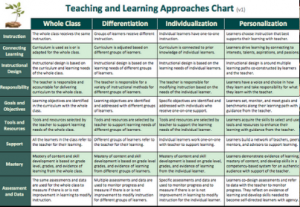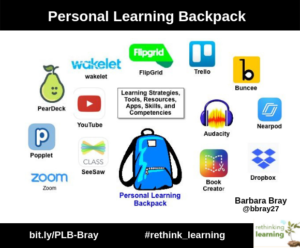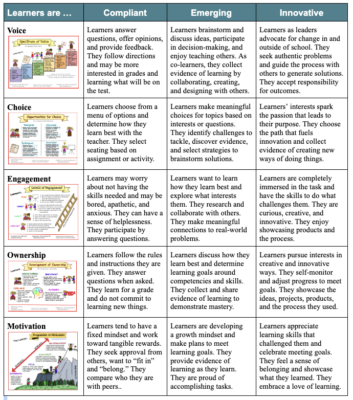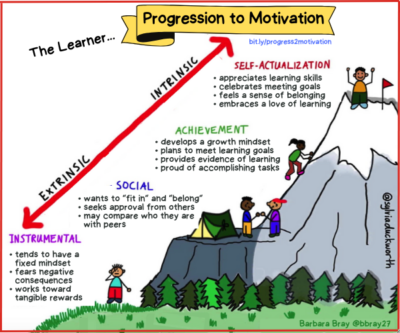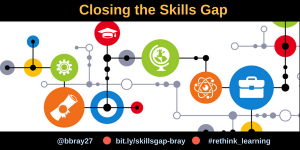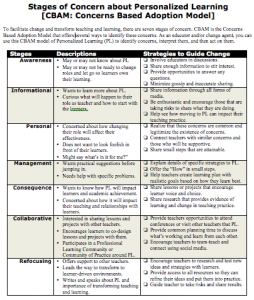The Rethinking Learning Toolkit includes resources that can help you, your school, district, or organization transform teaching and learning for learners of all ages. You can use this toolkit to:
- help you understand the language around personalized learning and agency.
- understand the different approaches for teaching and learning.
- understand Universal Design for Learning as the foundation to create learner-centered environments.
- design Learner Profiles and Personal Learning Backpacks.
- have the research and resources to support your journey to learner agency.
- use different graphics, the crosswalk, and the content to understand how learners move from compliance to agency.
- help close the skills gap by empowering learners to acquire the skills needed for their future.
- refer to CBAM Stages of Concern of Personalized Learning that educators may have as they change teaching practice.
Updated Charts on Teaching and Learning
This chart is meant as a guide and to calm the fears about changing what teachers know and do around teaching and learning. It is an updated version of the PDI Chart. How much value a teacher feels is in all of the approaches. It is all about the “person” who is learning. That can be the student and the teacher who is also learning about changing their teaching practice. Moving to agency takes time for students AND teachers. Students may not be ready to let go or have learned how to “do school” and may resist change. Teachers may not have the support, resources, or time to jump in and change how they teach right away. There is a link on this page to download the chart.
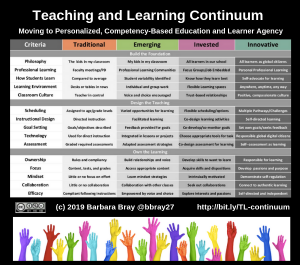 Teaching and Learning Continuum Moving to Personalized, Competency-Based Education and Learner Agency
Teaching and Learning Continuum Moving to Personalized, Competency-Based Education and Learner Agency
The Teaching and Learning Continuum was designed to support changing teaching practice and replaces the Stages of PLE chart. Teachers may not have the tools, resources, and support to change teaching practice on their own. The main challenge for teachers is time. Teachers have demonstrated how they can use this chart to take an existing lesson and look at areas where they can bring in voice, choice, and autonomy so students start developing learner agency. This is also a tool that schools can use to work together to change the culture.
New Resources on UDL, Learner Profiles, Backpack
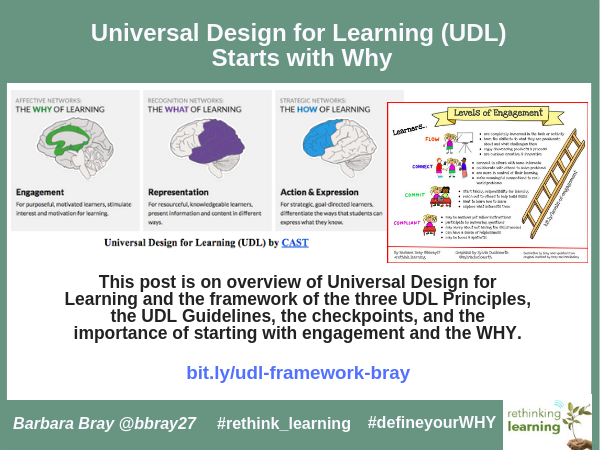 Universal Design for Learning (UDL) and your WHY for Learning
Universal Design for Learning (UDL) and your WHY for Learning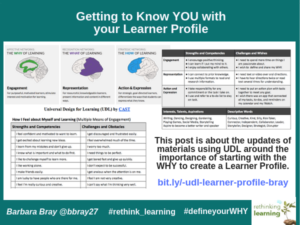 Learner Profile
Learner ProfileTaking what you learned about UDL and starting with the WHY of Learning, this post shares how you can use the “Me as a Learner” form to help understand how learners learn best. Then learners can create a Learner Profile with Strengths, Competencies, Challenges, and Wishes along with words that best describe them.
Crosswalk for Learners Moving to Autonomy, Authenticity, and Agency
This crosswalk uses a similar format from the Teaching and Learning Approaches and the Teaching and Learning Continuum charts above.
The Continuums for Voice, Choice, Engagement, Ownership, and Motivation that were originally developed by Barbara Bray and Kathleen McClaskey have been updated as new derivatives developed by Bray along with the graphics by Sylvia Duckworth. You can access the updated graphics and content using the links below.
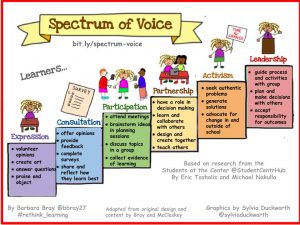 Spectrum of Voice: Developing Self-Regulation, Autonomy, and Agency
Spectrum of Voice: Developing Self-Regulation, Autonomy, and Agency
The Spectrum of Voice by Barbara Bray was adapted from the research “Motivation, Engagement, & Student Voice” by Toshalis & Nakkula for Students at the Center. This demonstrates how learners use voice in different ways depending on the situation, their confidence, and agency.
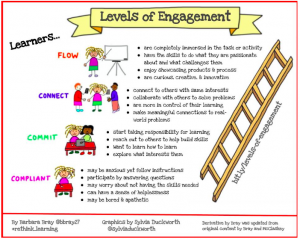 Levels of Engagement: Balancing Challenges and Skills
Levels of Engagement: Balancing Challenges and Skills
After reading more about engagement with the “Flow” theory and the differences between engagement and empowerment, it needed to be clear that engagement is about how much any learner is engaged in a task or activity and the balance between the challenge before them and the skills they have to meet that challenge. The levels of engagement pertains to who we defining we are as a learner.
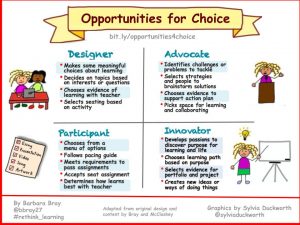 Opportunities for Choice: The Path to Advocacy and Innovation
Opportunities for Choice: The Path to Advocacy and Innovation
We used to believe that providing a pre-planned list of options was enough to give students opportunities for choice. When learners are the ones working harder than the teachers, they are empowered to take responsibility for the choices they make. They become advocates for owning and driving their learning.
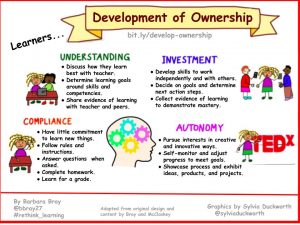 Development of Ownership: From Compliance to Autonomy
Development of Ownership: From Compliance to Autonomy
Most of us grew up in a system that valued sameness and compliance did not have a voice in their learning plus there was no ownership of learning except outside of school. This graphic and content explain how learners can move from compliance to autonomy by empowering learners to take responsibility for their choices as they invest in their learning.
Progression to Motivation: Moving to Self-Actualization
Extrinsic motivation occurs when we are motivated to perform a behavior or engage in an activity to earn a reward or to avoid punishment. Intrinsic motivation involves engaging in the behavior because it is personally rewarding; essentially, performing an activity for its own sake rather than the desire for some external reward.
Go to this page for more details
Future of Learning and Work
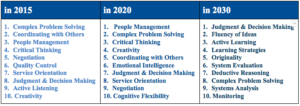 Skills and Dispositions Needed for the Future
Skills and Dispositions Needed for the Future
The world is changing. Employers are not finding people with the skills they need to do the jobs they defined. When you review the chart of skills from 2015 to 2030 from the World Economic Forum, you realize that we are not preparing learners for their future. Check out this post about how people can be upskilled or retrained for an uncertain future.
Go to this page for more details
Closing the Skills Gap
Are your students ready for their future? Colleges and businesses are looking for people who are curious, creative, and innovative people who are motivated to unlearn and relearn. What are the skills they will need?
Go to this page for more details
Supporting Educators
CBAM: Stages of Concern about Personalized Learning
Change is not easy. If you are planning to transform learning into a learner-centered environment, this adapted chart will help you define the stages of concern when you go through the change process. There are descriptions for each stage along with strategies to guide change. Coaches and administrators found this chart helps support transforming teaching and learning when they understand the concerns teachers have about changing practice.
 My eCoach was created to support educators in an online safe and secure community. Since 2003, over 20,000 members have had access to resources, multiple features, and collaborative tools, and each other.
My eCoach was created to support educators in an online safe and secure community. Since 2003, over 20,000 members have had access to resources, multiple features, and collaborative tools, and each other.
 My eCoach has been transferred to K12Leaders.com
My eCoach has been transferred to K12Leaders.com
A first round of members have been transferred to K12Leaders and have access to all features in the K12Leaders platform.

